Quantum-Chromodynamics-Inspired 2D Multicolor LED Matrix to Camera Communication for User-Centric MIMO
Abstract
1. Introduction
- To use quantum chromodynamics principles for data to color map using an LED matrix.
- To provide rotation support for the OCC using a QR code-inspired anchoring pattern.
- To build and evaluate the simulator of proposed QCD-inspired OCC modulation with rotation support and MIMO.
- To build a low-cost prototype of the proposed QCD-OCC system and compare the success of reception (%) with the proposed simulator.
- To evaluate the performance of the proposed system on the basis of metrics such as SNR, the success of reception (%), intensity profile, throughput, and BER.
2. Proposed Communication System
2.1. Proposed Technique
2.2. Overview of Proposed Communication System
- Format 1: In this format, three separate binary data streams, , , and , of variable lengths for users , , and are used to generate a 3D matrix of size 1 × 48 × 3, as shown in Equation (2), where matrices R, G, and B are submatrices along the Z axis at Indices 1, 2, and 3, respectively.
- Format 2: in this format, a single binary data stream D is folded to obtain a 3D matrix of size 1 × 48 × 3, as shown in Equation (3).
3. Realization of Proposed QCD–OCC System
3.1. Implementation of Proposed QCD–OCC Transmitter Simulation
3.2. Implementation of Proposed QCD–OCC Receiver Simulation
3.3. Implementation of Proposed QCD–OCC System Prototype
| Algorithm 1 QCD–OCC for transmitter. |
|
| Algorithm 2 Supporting Functions: SetAnchorPattern. |
|
| Algorithm 3 Supporting functions: SetTopDataPattern. |
|
| Algorithm 4 Supporting functions: SetBottomDataPattern. |
|
| Algorithm 5 Supporting functions: SetMidDataPattern. |
|
4. Experimental Setup and Results
5. Conclusions and Future Work
Author Contributions
Funding
Institutional Review Board Statement
Informed Consent Statement
Data Availability Statement
Conflicts of Interest
Abbreviations
| LED | Light-emitting diode |
| RF | Radio frequency |
| VLC | Visible-light communication |
| OCC | Optical camera communication |
| QCD | Quantum chromodynamics |
| MIMO | Multiple-input multiple-output |
| RoI | Region of interest |
| Tx | Transmitter |
| Rx | Receiver |
| PDM | Pulse duration modulation |
| PSNR | Peak signal-to-noise ratio |
| BER | Bit-error ratio |
| bps | Bits per second |
References
- Ali, M.O.; Alam, M.M.; Ahmed, M.F.; Jang, Y.M. A New Smart-Meter Data Monitoring System based on Optical Camera Communication. In Proceedings of the 2021 International Conference on Artificial Intelligence in Information and Communication (ICAIIC), Jeju Island, Korea, 13–16 April 2021; pp. 477–479. [Google Scholar] [CrossRef]
- Cahyadi, W.A.; Chung, Y.H.; Ghassemlooy, Z.; Hassan, N.B. Optical Camera Communications: Principles, Modulations, Potential and Challenges. Electronics 2020, 9, 1339. [Google Scholar] [CrossRef]
- Uysal, M.; Miramirkhani, F.; Narmanlioglu, O.; Baykas, T.; Panayirci, E. IEEE 802.15.7r1 Reference Channel Models for Visible Light Communications. IEEE Commun. Mag. 2017, 55, 212–217. [Google Scholar] [CrossRef]
- Salvi, S.; Vasantha, G. An Optical Camera Communication Using Novel Hybrid Frequency Shift and Pulse Width Modulation Technique for Li-Fi. Computation 2022, 10, 110. [Google Scholar] [CrossRef]
- Hasan, M.K.; Chowdhury, M.Z.; Shahjalal, M.; Nguyen, V.T.; Jang, Y.M. Performance Analysis and Improvement of Optical Camera Communication. Appl. Sci. 2018, 8, 2527. [Google Scholar] [CrossRef]
- Nguyen, H.; Nguyen, V.; Nguyen, C.; Bui, V.; Jang, Y. Design and Implementation of 2D MIMO-Based Optical Camera Communication Using a Light-Emitting Diode Array for Long-Range Monitoring System. Sensors 2021, 21, 3023. [Google Scholar] [CrossRef] [PubMed]
- Preda, R.O.; Dobre, R.A.; Badea, R.A. Influence of Camera Framerate Variations on an Optical Camera Communication System. In Proceedings of the 2021 44th International Conference on Telecommunications and Signal Processing (TSP), Brno, Czech Republic, 26–28 July 2021; pp. 316–319. [Google Scholar] [CrossRef]
- Liu, A.; Shi, W.; Ouyang, M.; Liu, W. Characterization of Optical Camera Communication Based on a Comprehensive System Model. J. Light. Technol. 2022, 40, 6087–6100. [Google Scholar] [CrossRef]
- Jung, H.; Kim, S.M. Experimental Demonstration of 3 × 3 MIMO LED-to-LED Communication Using RGB Colors. Sensors 2021, 21, 4921. [Google Scholar] [CrossRef] [PubMed]
- Bao, X.; Pan, J.; Cai, Z.; Li, J.; Huang, X.; Chen, R.; Fang, J. Real-time display camera communication system based on LED displays and smartphones. Opt. Express 2021, 29, 23558–23568. [Google Scholar] [CrossRef] [PubMed]
- Do, T.H.; Yoo, M. A simple LED panel dection algoritum for Optical Camera Communication systems. In Proceedings of the 2019 International Conference on Information and Communication Technology Convergence (ICTC), Jeju Island, Korea, 16–18 October 2019; pp. 747–749. [Google Scholar] [CrossRef]
- Guan, W.; Li, J.; Wen, S.; Zhang, X.; Ye, Y.; Zheng, J.; Jiang, J. The Detection and Recognition of RGB-LED-ID Based on Visible Light Communication using Convolutional Neural Network. Appl. Sci. 2019, 9, 1400. [Google Scholar] [CrossRef]
- Sun, X.; Shi, W.; Cheng, Q.; Liu, W.; Wang, Z.; Zhang, J. An LED Detection and Recognition Method Based on Deep Learning in Vehicle Optical Camera Communication. IEEE Access 2021, 9, 80897–80905. [Google Scholar] [CrossRef]
- Teli, S.R.; Matus, V.; Zvanovec, S.; Perez-Jimenez, R.; Vitek, S.; Ghassemlooy, Z. Optical Camera Communications for IoT–Rolling-Shutter Based MIMO Scheme with Grouped LED Array Transmitter. Sensors 2020, 20, 3361. [Google Scholar] [CrossRef] [PubMed]
- Zinda, T.; Ito, K.; Chujo, W. Rolling-Shutter-Based Optical Camera Communication Using Distributed LED Array. In Proceedings of the 2018 11th International Symposium on Communication Systems, Networks and Digital Signal Processing (CSNDSP), Budapest, Hungary, 18–20 July 2018; pp. 1–4. [Google Scholar] [CrossRef]
- Nguyen, H.; Jang, Y.M. Design and Implementation of Rolling Shutter MIMO-OFDM scheme for Optical Camera Communication System. In Proceedings of the 2021 International Conference on Information and Communication Technology Convergence (ICTC), Jeju Island, Korea, 20–22 October 2021; pp. 798–800. [Google Scholar] [CrossRef]
- Teli, S.R.; Zvanovec, S.; Perez-Jimenez, R.; Ghassemlooy, Z. Spatial frequency-based angular behavior of a short-range flicker-free MIMO–OCC link. Appl. Opt. 2020, 59, 10357–10368. [Google Scholar] [CrossRef] [PubMed]
- Gorse, L.; Löffler, C.; Mutschler, C.; Philippsen, M. Optical Camera Communication for Active Marker Identification in Camera-based Positioning Systems. In Proceedings of the 2018 15th Workshop on Positioning, Navigation and Communications (WPNC), Bremen, Germany, 25–26 October 2018; pp. 1–6. [Google Scholar] [CrossRef]
- Nguyen, T.; Jang, Y.M. Novel 2D-sequential color code system employing Image Sensor Communications for Optical Wireless Communications. ICT Express 2016, 2, 57–62. [Google Scholar] [CrossRef]
- Hao, T.; Zhou, R.; Xing, G. COBRA: Color Barcode Streaming for Smartphone Systems. In Proceedings of the 10th International Conference on Mobile Systems, Applications, and Services—MobiSys ’12, Seoul, Korea, 17–21 June 2012; Association for Computing Machinery: New York, NY, USA, 2012; pp. 85–98. [Google Scholar] [CrossRef]
- Han, T.; Zhao, D. Energy Efficiency of User-Centric, Cell-Free Massive MIMO-OFDM with Instantaneous CSI. Entropy 2022, 24, 234. [Google Scholar] [CrossRef] [PubMed]
- Chen, C.; Yang, H.; Du, P.; Zhong, W.D.; Alphones, A.; Yang, Y.; Deng, X. User-Centric MIMO Techniques for Indoor Visible Light Communication Systems. IEEE Syst. J. 2020, 14, 3202–3213. [Google Scholar] [CrossRef]
- Olsen, S.L.; Skwarnicki, T.; Zieminska, D. Nonstandard heavy mesons and baryons: Experimental evidence. Rev. Mod. Phys. 2018, 90, 015003. [Google Scholar] [CrossRef]
- Gallmeister, K.; Mosel, U. Hadronization and Color Transparency. Physics 2022, 4, 440–450. [Google Scholar] [CrossRef]
- Ahmed, M.F.; Hasan, M.K.; Shahjalal, M.; Alam, M.M.; Jang, Y.M. Experimental Demonstration of Continuous Sensor Data Monitoring Using Neural Network-Based Optical Camera Communications. IEEE Photonics J. 2020, 12, 1–11. [Google Scholar] [CrossRef]
- Huynh-Thu, Q.; Ghanbari, M. The accuracy of PSNR in predicting video quality for different video scenes and frame rates. Telecommun. Syst. 2012, 49, 35–48. [Google Scholar] [CrossRef]
- Nguyen, H.; Nguyen, H.; Nguyen, V.H.; Jang, Y.M. Design and Implementation of AS-QL Scheme for LED Matrix based Optical Camera Communication. In Proceedings of the 2020 International Conference on Information and Communication Technology Convergence (ICTC), Jeju Island, Korea, 21–23 October 2020; pp. 674–676. [Google Scholar] [CrossRef]
- Yilmazlar, I.; Sabuncu, M. Implementation of a Current Drive Modulator for Effective Speckle Suppression in a Laser Projection System. IEEE Photonics J. 2015, 7, 1–6. [Google Scholar] [CrossRef]
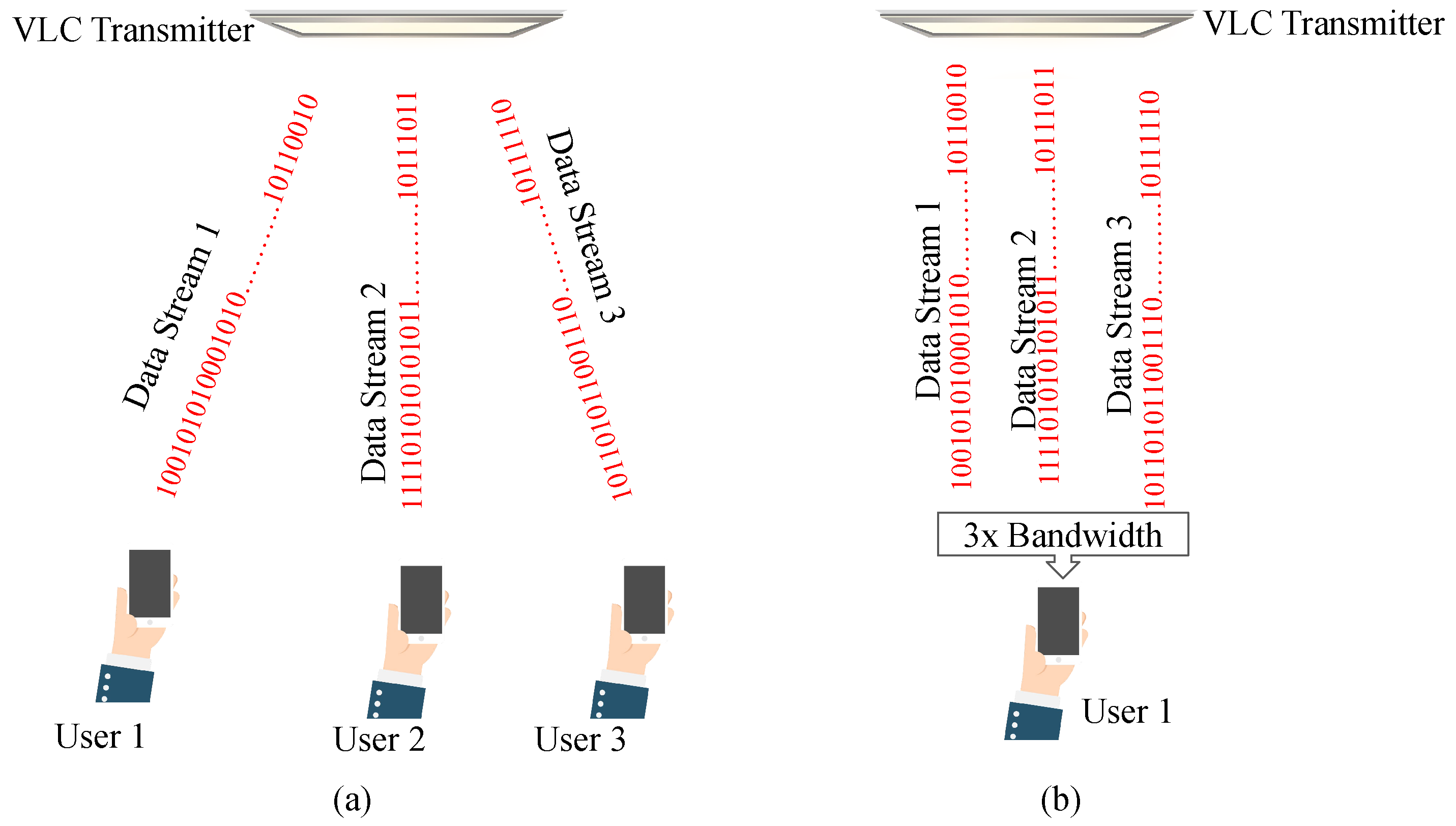
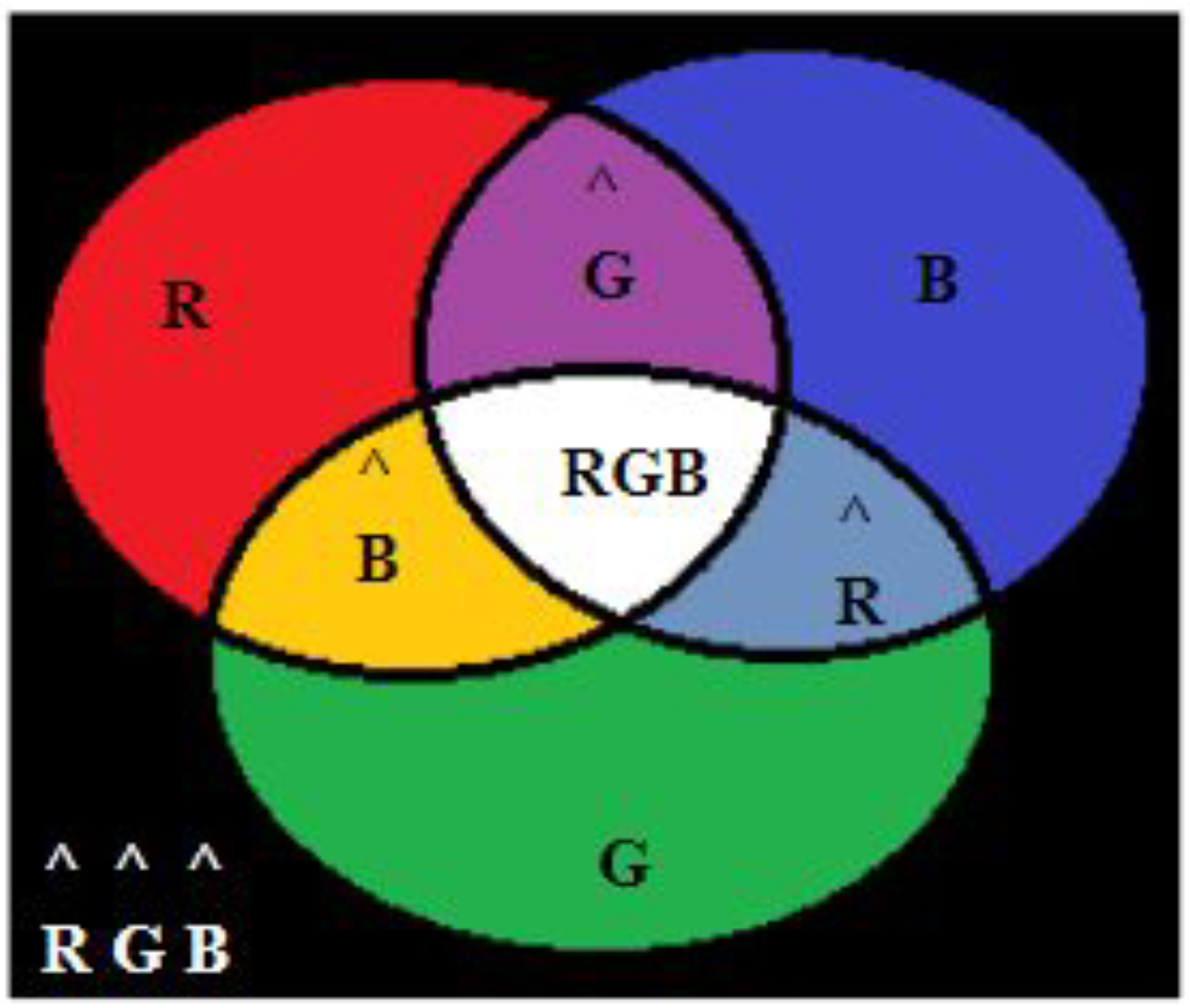

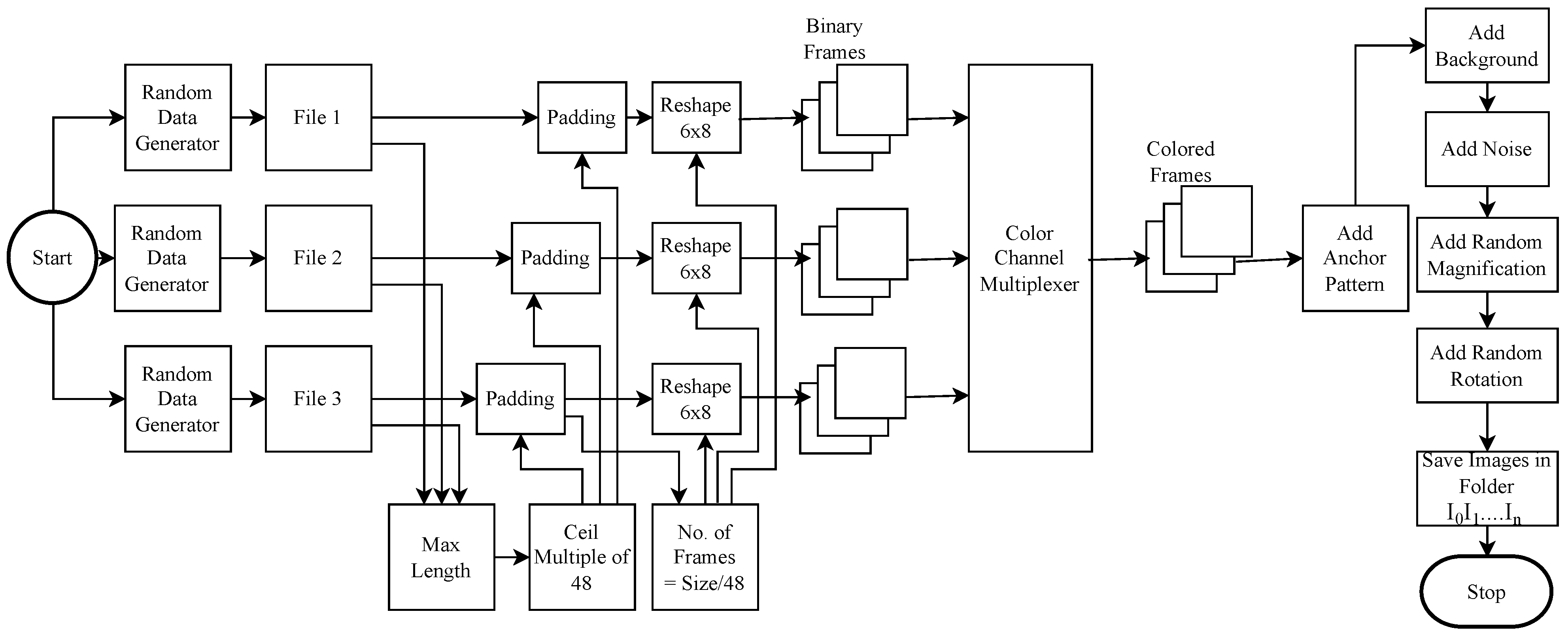
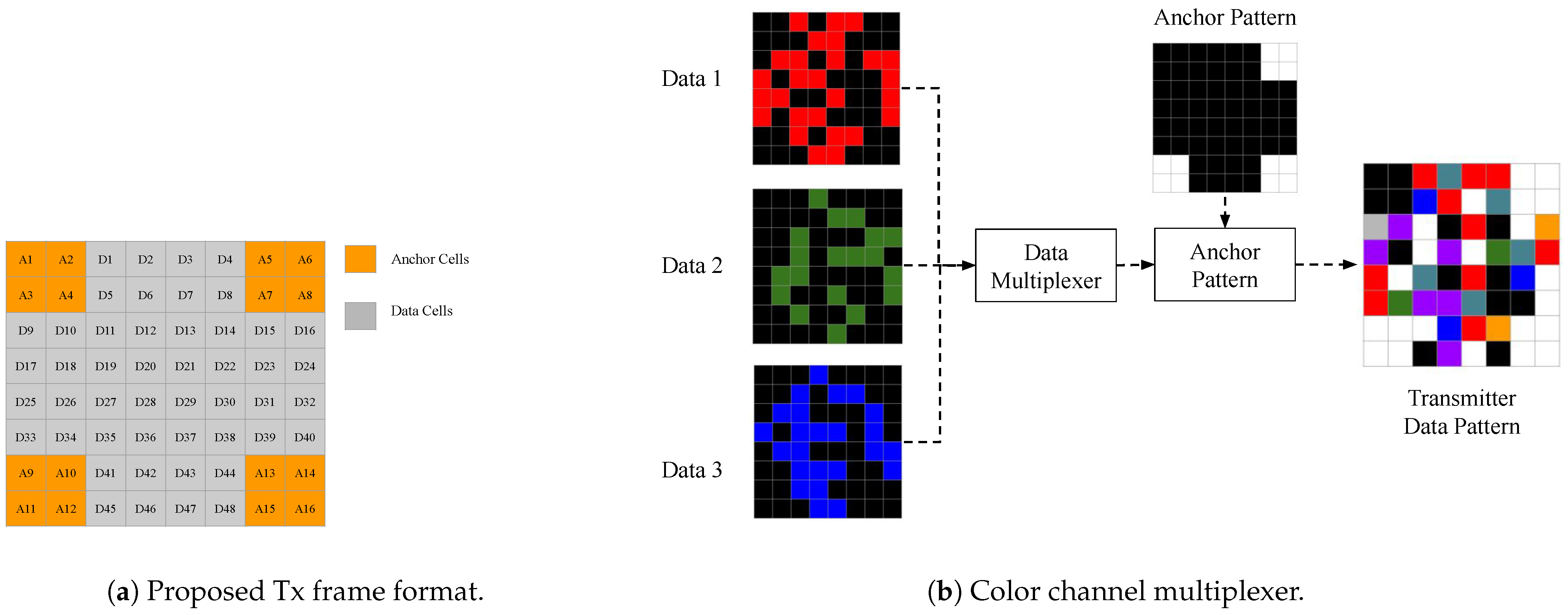
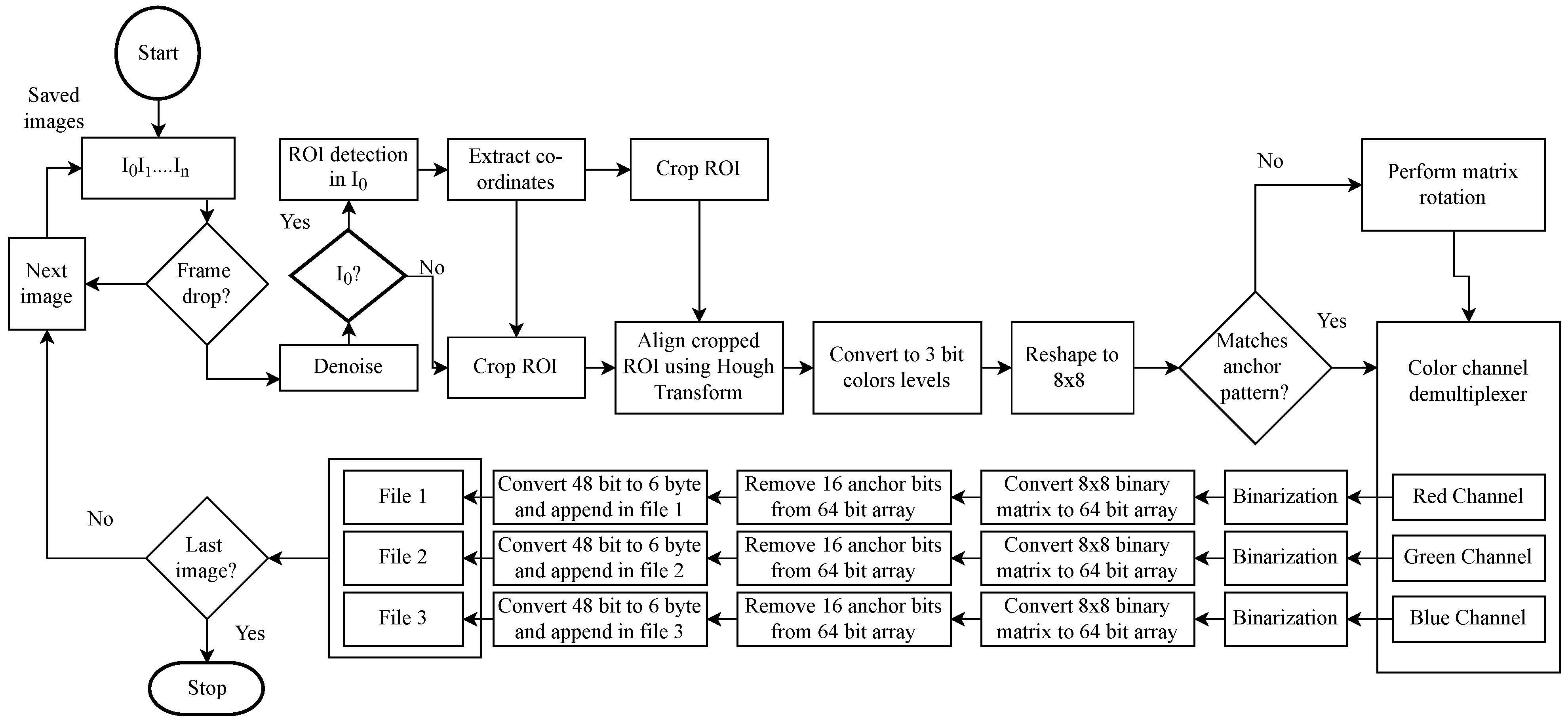
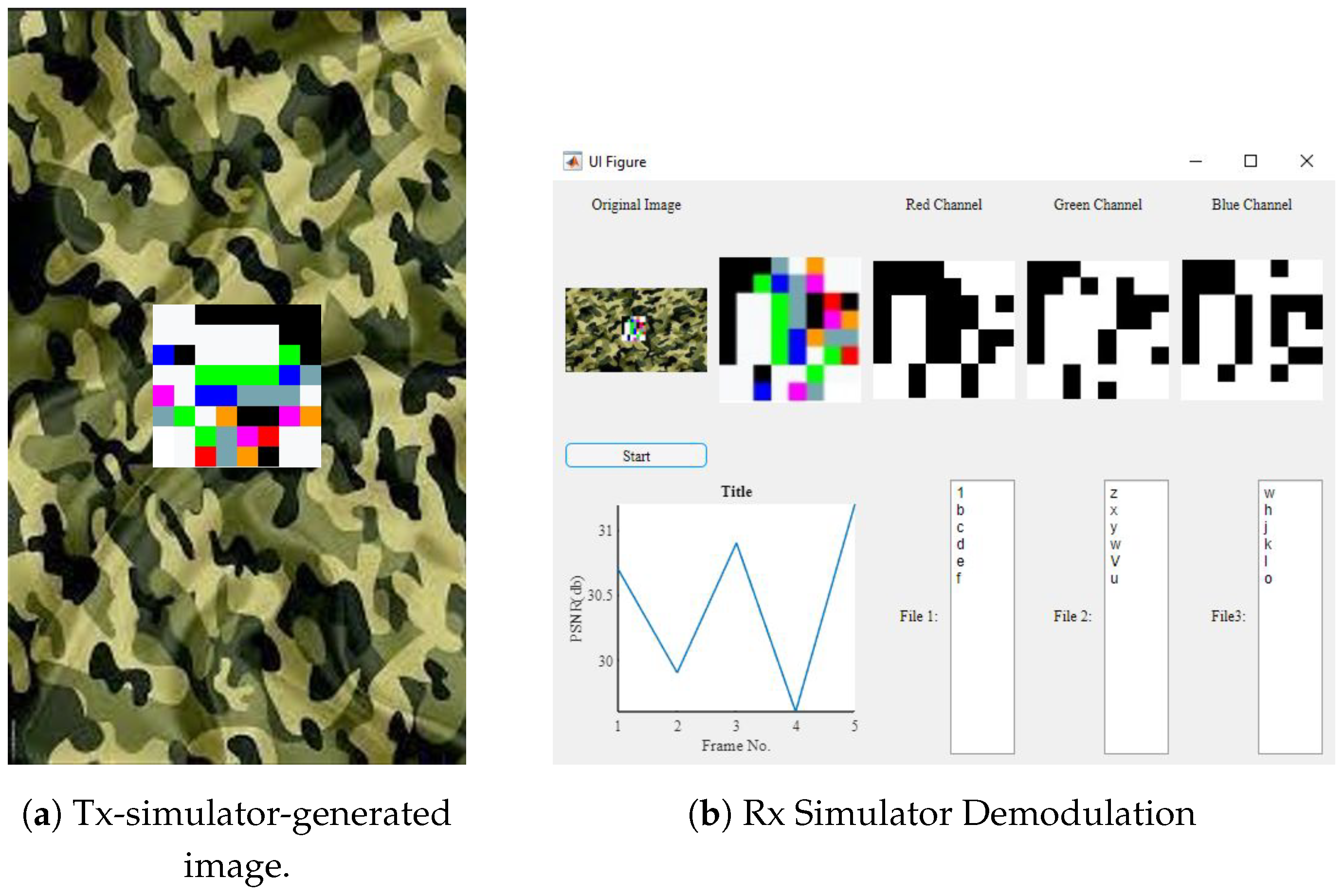


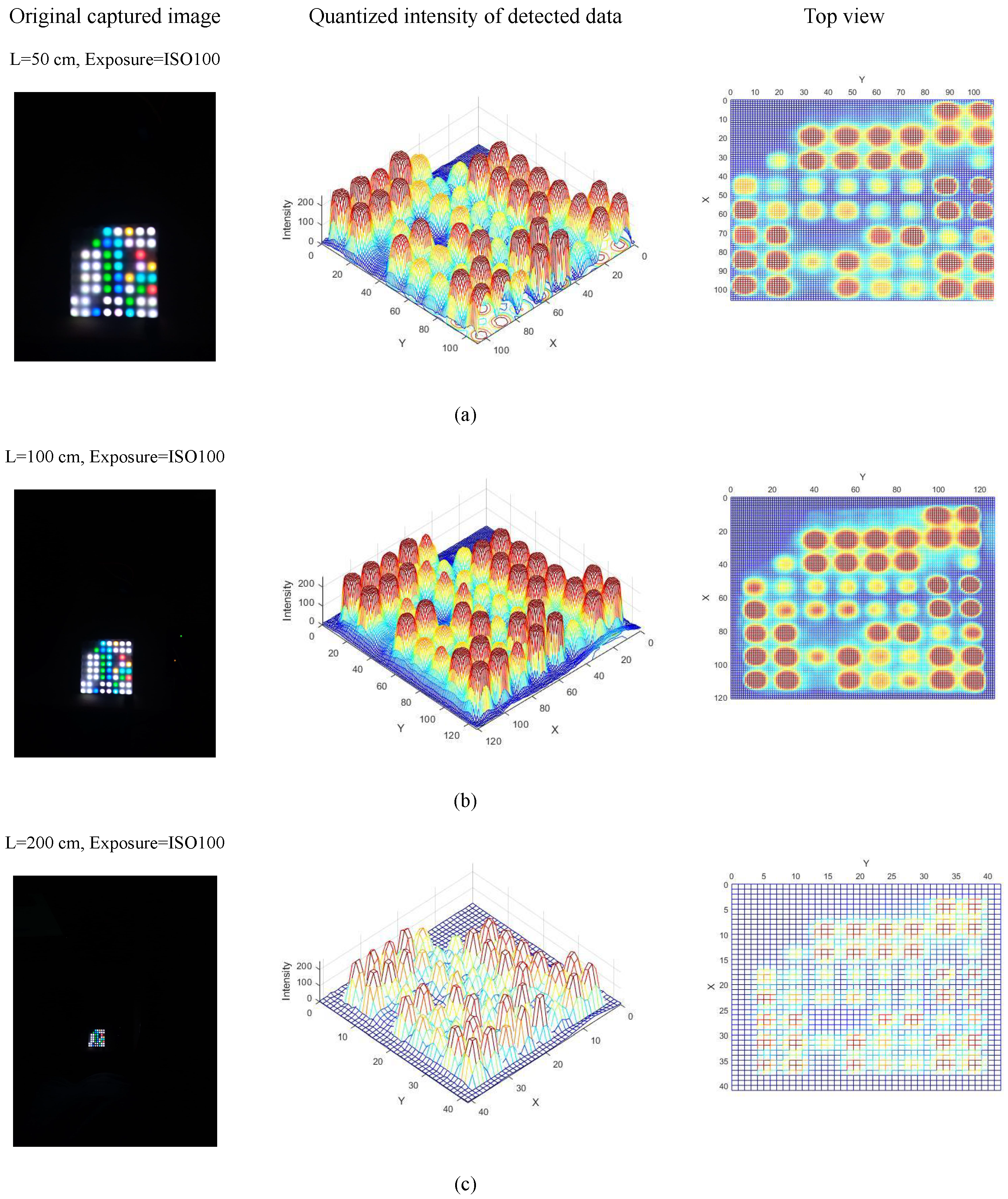
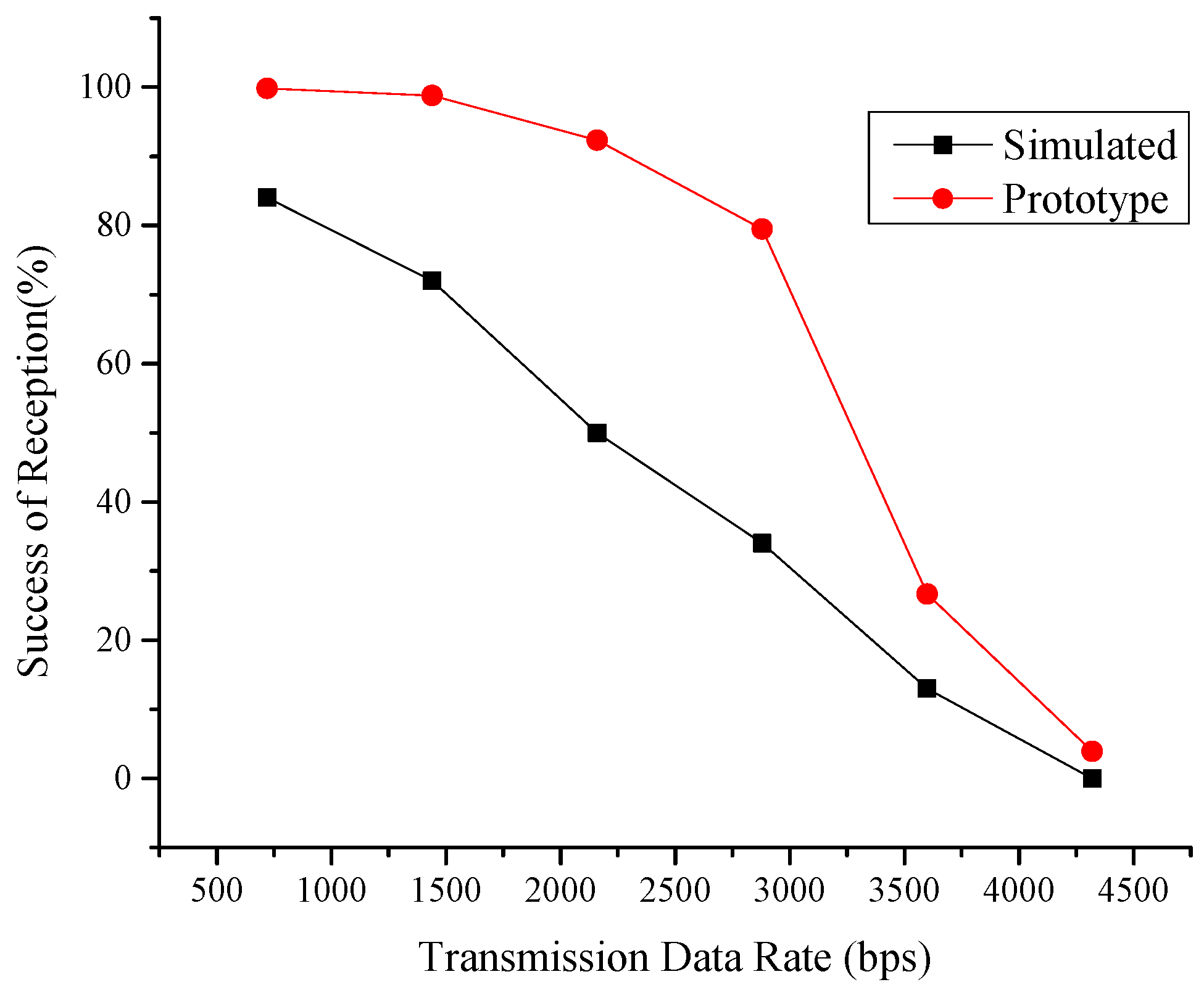


| Bits | Color | Bits | Color |
|---|---|---|---|
| 000 | R̂ĜB̂ = Black | 111 | RGB = White |
| 001 | B = Blue | 110 | B̂ = Yellow |
| 010 | G = Green | 101 | Ĝ = Violet |
| 100 | R = Red | 011 | R̂ = Cyan |
| Parameter | Value | Parameter | Value |
|---|---|---|---|
| Tx dimension | 6.5 × 6.5 cm | CPU | i7-700 3.6GHz |
| Tx model | WS2812B-64 8 × 8 LED Matrix | RAM | 16 GB |
| Transmission Data rates | 720, 1440, 2160, 2880, 3600, 4320 bps | File sizes | File 1: 97 bytes File 2: 123 bytes File 3: 109 bytes |
| Camera Frame rate | 30 fps 1/1500s | Distances | 50, 100, 150, 200 cm |
| Camera Resolution | 1920 × 1080 pixels | Ambient light | 27, 149, 304 lux |
| Exposure | ISO100 | Rotation angle | 0, 45, 90 |
| Technique | Tx Device | Camera FPS | Distance | Flicker | Rotation Support | Type of Camera | Number of Links | BER | Throughput |
|---|---|---|---|---|---|---|---|---|---|
| RS-OCC- MIMO [14] | 8 × 8 LED Panel | 30 | <1.5 m | No | No | RS | 1 | > | 1.4 Kbps |
| Data Matrix | 8 × 8 LED Panel | 30 | <2 m | Yes | No | GS | 1 | > | 1.9 Kbps |
| QR Code (Single Color) | 8 × 8 LED Panel | 30 | <3 m | Yes | Yes | GS | 1 | - | 1.44 Kbps |
| AS-QL [27] | 8 × 8 LED Panel | 60 | - | Yes | Yes | GS | 1 | ≈ | 1.180 Kbps |
| QR Code (Multi-Color) [19] | LCD Display | 60 | <3 m | Yes | Yes | RS+GS | Multiple | > | 5.4 Kbps |
| Proposed QCD-OCC | 8 × 8 LED Panel | 30 | <3 m | Yes | Yes | RS+GS | Multiple | > | 4.32 Kbps |
Publisher’s Note: MDPI stays neutral with regard to jurisdictional claims in published maps and institutional affiliations. |
© 2022 by the authors. Licensee MDPI, Basel, Switzerland. This article is an open access article distributed under the terms and conditions of the Creative Commons Attribution (CC BY) license (https://creativecommons.org/licenses/by/4.0/).
Share and Cite
Vasantha, G.; Salvi, S. Quantum-Chromodynamics-Inspired 2D Multicolor LED Matrix to Camera Communication for User-Centric MIMO. Appl. Sci. 2022, 12, 10204. https://doi.org/10.3390/app122010204
Vasantha G, Salvi S. Quantum-Chromodynamics-Inspired 2D Multicolor LED Matrix to Camera Communication for User-Centric MIMO. Applied Sciences. 2022; 12(20):10204. https://doi.org/10.3390/app122010204
Chicago/Turabian StyleVasantha, Geetha, and Sanket Salvi. 2022. "Quantum-Chromodynamics-Inspired 2D Multicolor LED Matrix to Camera Communication for User-Centric MIMO" Applied Sciences 12, no. 20: 10204. https://doi.org/10.3390/app122010204
APA StyleVasantha, G., & Salvi, S. (2022). Quantum-Chromodynamics-Inspired 2D Multicolor LED Matrix to Camera Communication for User-Centric MIMO. Applied Sciences, 12(20), 10204. https://doi.org/10.3390/app122010204






